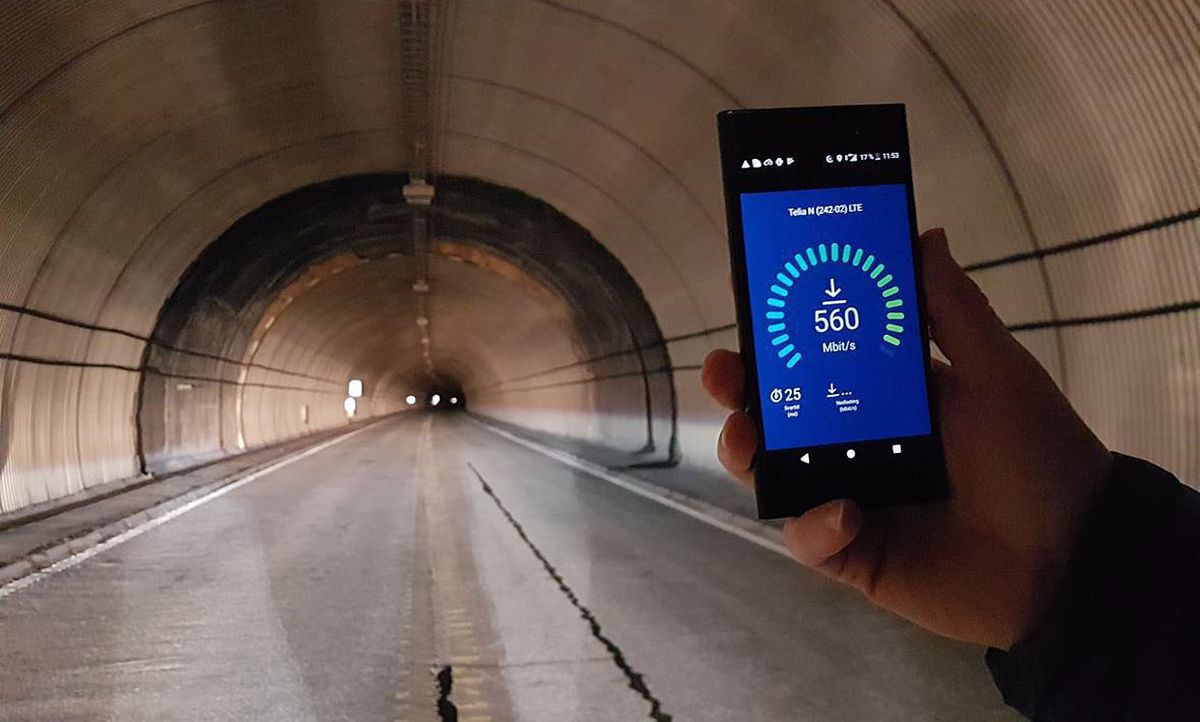If you’ve ever tried to stream a video on your mobile device while traveling by train, you may be familiar with the sense of dread that tunnels inspire: Right in the middle of watching your show, the video is interrupted because the mobile signal can’t penetrate through the tunnel and into the train. This frustrating experience may soon be a thing of the past—in Norway, at least.
Mobile operators there recently worked with Germany-based Radio Frequency Systems (RFS)—a designer and manufacturer of cable, antenna, and tower systems—to break the record for in-tunnel download speeds for a mobile network.
As part of the Norwegian Ministry of Transport’s Follo Line project, mobile operators Telia, Telenor, and Bane NOR along with RFS recorded download speeds of 560 megabits per second (Mb/s) in a 20-kilometer abandoned road tunnel in Holmestrand, Norway. The previous maximum speed in such conditions had been around 145 Mb/s in a typical 2 x 2 multiple-input multiple-output (MIMO setup), which is currently implemented in various tunnels globally, according to Andreas Bergmeister, a product manager at RFS.
Bergmeister added that even if you were to extrapolate out the previous record to a 4 x 4 MIMO system—which has not yet been implemented anywhere—it would still only achieve theoretically around 300 Mb/s. “So the 560 Mb/s is the new world record figure,” said Bergmeister.
The results have not been published in a journal, but Bergmeister described the experimental setup in an interview. Inside the tunnel, RFS deployed its radiating cables connected to a radio transmitter with 4G 4 x 4 MIMO capability. These cables essentially create a flexible base station that runs along the inside of a tunnel.
The test started by using a 2 x 2 MIMO setup that utilized a horizontally polarized radiating cable and a vertically polarized radiating cable. The number of cables essentially doubled in the 4 x 4 MIMO setup. The results achieved approximately 95 percent of theoretical maximum speeds for 4 x 4 MIMO in the tunnel.
The effort also demonstrated a 100 percent increase in download rates when going from single-input single-output (SISO) to 2 x 2 MIMO and an additional 100 percent increase in download rates from 2 x 2 MIMO to 4 x 4 MIMO.
While it might seem like it would be harder to get signals to propagate to a tunnel that runs underground, it’s typically more difficult to get signals to penetrate through the cars of the train, according to Bergmeister.
“You have a metal block with some small windows; in some cases the windows are even metallic,” said Bergmeister. “So the radiating cable—although invented by RFS in 1972—is still the go-to solution to provide coverage and capacity in such confined areas.”
Bergmeister explains that in order to upgrade MIMO in a tunnel, you essentially need to double the infrastructure placed there. So for 2 x 2, you have two runs of cables, and for 4 x 4, you need four parallel runs. Bergmeister notes that, conceptually, it’s possible to do MIMO 2 x 2 with just one cable or 4 x 4 with two cables, but these approaches present limitations to the system.
What this all means for users is that they will be able to stream videos on a train going through a tunnel.
Bergmeister added: “The Norwegian operators do have a target of 5 Mb/s per active user, which will allow continuous streaming of videos in very high quality/resolution for all users simultaneously.”
Dexter Johnson is a contributing editor at IEEE Spectrum, with a focus on nanotechnology.



